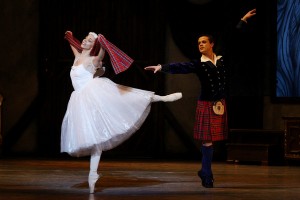By Rachel Straus
The Slovak National Theatre Ballet in Bratislava is not a destination point for international balletomanes, but it should be if one wants to see August Bournonville’s La Sylphide up close and personal. In the city’s neo-Renaissance theatre, the 92-year old ballet troupe performs regularly. Being there on October 6 felt like visiting the interior of a Faberge egg.
When La Sylphide‘s supernatural and realistic aspects collide, when the mime sections are as affecting as the dancing, the ballet ceases to be a historical document: i.e. the longest continuously performed Romantic ballet. It becomes a dark morality tale. In it a Scottish bloke abandons his bride at the altar for a hyper-feminine creature. He wishes to possess her; he ends up killing her. Too often the production gets mired in ballerina doll sweetness, but not in this case.
In Bratislava, the real star of the ballet was not the title character, danced by beautiful Viola Marina. It was Kvetoslava Štefeková, who performed Madge the witch. Unlike the Royal Danish Ballet’s production seen last year in New York, this version gives greater attention to the crucial role of Madge, who sets nearly every turn of the story in motion. (For a plot refresher, click here.)
Štefeková’s Madge is no arthritic hag. She’s an athletic feminist who dislikes wishy-washy men. Before she grabs the poison scarf and gives it to James (Oliver Jehelka) to give to the Sylphide, she twirls across the stage like a tornado. In the ballet’s final moments, she grabs Jehelka by his hair and violently lifts his head so that he witnesses the Sylphide’s funeral cortege. This Madge abhors James’s choice: to leave his bride Effie (Veronika Hollá) for an unearthly woman. This Madge ensures that Effie is not left alone. She literally pushes Gurn (Andrej Kremz) into proposing to the humiliated girl. The fact that Effie accepts Gurn without fuss underscores the condition of early 19thcentury women—and the no-nonsense approach of the Slovak National Ballet Theatre to accurately depict women’s lack of historical power.
While Hollá (Effie) plays the good girl and Mariner performs a Marilyn Monroe-like Sylphide, Štefeková’s Madge comes across as a modern female personality. She projects joy and rage, curiosity and condemnation. As the curtain lowers on a crumpled James (Jehelka), Stefekova raises her fists above her head. Here is a woman in bitter triumph, something rarely seen in the denouement of Romantic ballets or, for that matter, in contemporary works where the classical technique is featured.
The other notable aspect of this La Sylphide, staged by former Bournonville principal dancer Niehls Kehlet, was it’s mis-en-scène—and I don’t mean the set design. I mean the dancers’ relationship to the smallness of the stage. Compared to North American stages, this one is tiny. In this environment, every detail of the dancers’ performance is brought into relief. When Mariner (the Sylphide) bats her eyes at Jahelka (James) for the first time, I could actually see her eyelids and the gently lilt of her fingers underneath her opalescent face. What was made clear was that this woman is as beautiful as she is practiced at tendering her feminine wiles.
The Austrian-born Mariner possesses Taglioni-like arms and the neck of Anna Pavlova. Her arabesque is the best part of her dancing. As she effortlessly lifts one leg behind her, she simultaneously balances and grows beyond the shape. The effect is that of flying. And that’s the point: Sylphs can fly. But apart from Mariner’s soaring arabesque and lovely arms, she dances without enriching H.S. von Lövenskjold’s plaintive music as competently conducted by Martin Leginus. Her body doesn’t sing it as much as keep time with the tempi.
As for the Slovak National Theatre Ballet’s female corps, they were a model of synchronization—a vision of sisterly sylphdom.
Slovak National Theatre website
Tags: Andrej Kremz, Anna Pavlova, August Bournonville, Bratislava, H.S. von Lövenskjold, Kvetoslava , La Sylphide, Marie Taglioni, Marilyn Monroe, Martin Leginus, Niehls Kehlet, Oliver Jahelka, Royal Danish Ballet, Slovak National Theatre Ballet, Veronika Hollá, Viola Mariner

